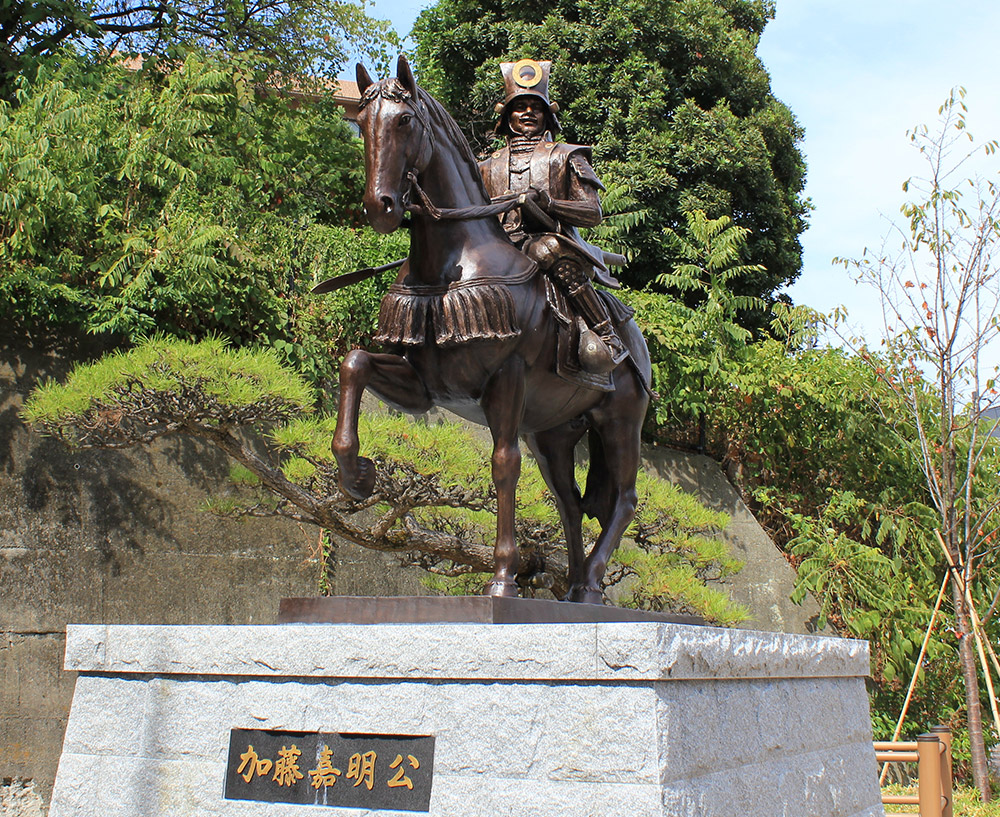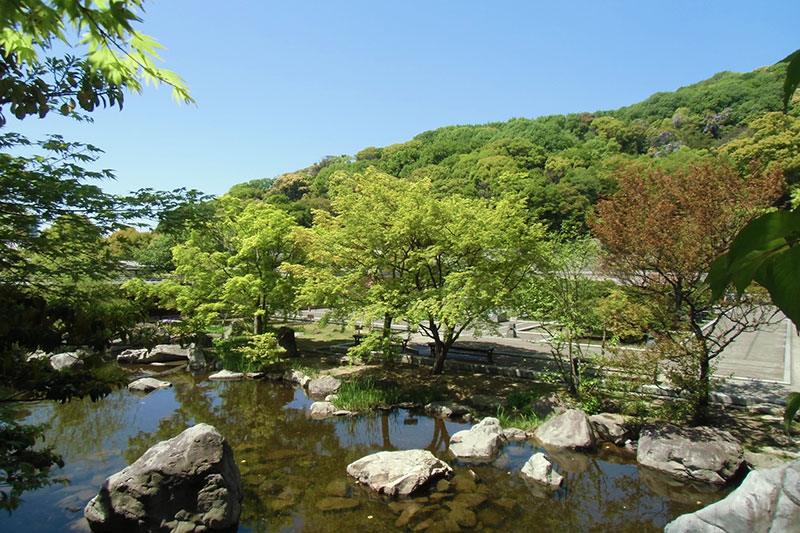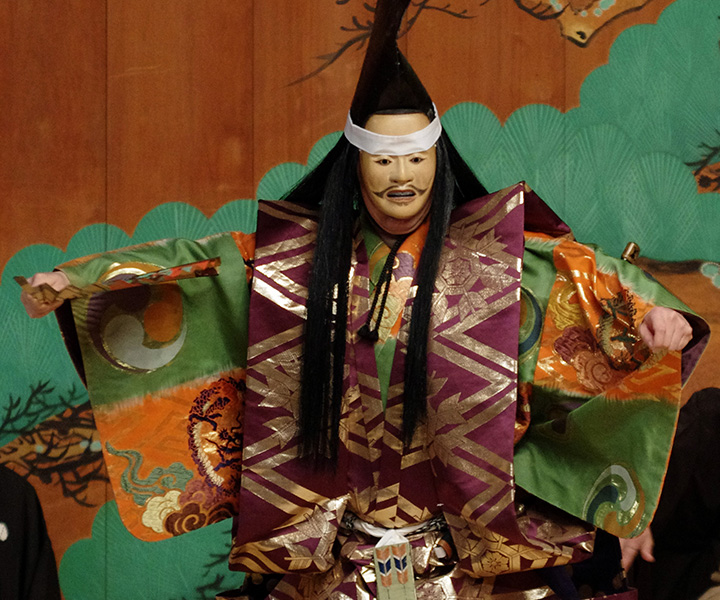- TOP
- 能楽を旅する 松山城_en
Matsuyama Castle’s History and Major Figures

Kato Yoshiaki built the main castle (Honmaru)
The founder of Matsuyama Castle is Kato Yoshiaki (photo). Kato Yoshiaki was a member of the Tokugawa forces that won the Battle of Sekigahara. He was gifted Iyo (present-day Ehime Prefecture) for his achievement in battle. He then began the construction of Matsuyama Castle in 1602.
However, Kato Yoshiaki was transferred to the Aizu domain (present-day Fukushima Prefecture) when the main castle was completed.
After Kato Yoshiaki's transfer, Gamo Tadatomo became the lord of the castle and began to expand the Ninomaru (※1) of Kumamoto Castle. However, in 1634, Gamo Tadatomo died of illness. Since Gamo Tadatomo had no heir, the Gamo family ceased to exist.
(※1 Outer citadel)

The first generation of the Matsudaira family began major renovations, which were completed when the family was in the 12th generation
The year after Gamo Tadatomo died, Matsudaira Sadayuki became the lord of Matsuyama and began a major reconstruction of the castle. However, in 1784, the castle tower and many other buildings were destroyed by fire caused by a lightning strike.
The Matsudaira family asked the Edo Shogunate to rebuild the castle, and in 1820, reconstruction work began. 33 years later, in 1852, the castle tower was completed when Matsudaira Katsuyoshi (photo), the 12th generation of the Matsudaira family, took power.
Discover the Relationship Between Matsuyama Castle and Noh!
Matsuyama Castle×Noh

Townspeople also stood on the Noh stage of Matsuyama Castle for Machiirinoh
In Matsuyama Castle during the Iyo Matsuyama domain period, Noh stages were built in the Ninomaru and Sannomaru areas. Noh were performed for domain ceremonies and celebrations.
For celebratory occasions, the Edo shogunate allowed the townspeople special access to Noh performances. These Noh performances were called "Machiirinoh.” Following the Edo Shogunate's lead, the Matsuyama domain held many Machiirinoh performances.
In August 1759, two of the five days of Noh performances were Machiirinoh. After the Noh performers left the stage at the end of the first half of the performance, food, red bean rice , rice cakes, and sake were served to the townspeople during the intermission.
Just having the domain’s Noh performers perform was not sufficient because there were so many performances over the five days. Therefore, the townspeople helped with the flutes, drums, chorus groups, and shite tsure (the main character's assistants), making for a lively event.
※2 Photo:Annotations are at the bottom

Tsuji Noh becomes popular around Matsuyama Castle
Around 1700, "Tsuji Noh" began to be held under Matsuyama Castle, partly due to the influence of Machiirinoh. Tsuji Noh is a Noh for the masses performed at the streets, and temples and shrines of the town. Especially after 1751, the Sen-suke Horii Noh troupe became popular and a "Sen-suke Noh boom" occurred.
Many tours of Sensuke Noh were made. The touring performances were held at outdoor venues such as today's Anumami Shrine, where 15 to 16 actors of the troupe performed five Noh plays, and three to four Kyogen plays in a single day. In addition, one actor played multiple roles.
Some of the performances included grand scale pieces such as the Noh "Shakkyo" and "Dojoji”.

Shinonome Shrine
The Noh masks and costumes of the Matsuyama domain were auctioned off at the time of the Meiji Restoration. However, Ikeuchi Nobuo, a former domain member, and others worked hard to preserve them, and the Noh masks and costumes of the Matsuyama domain were dedicated to Shinonome Shrine in Matsuyama City. Currently, 153 Noh masks, 42 Kyogen masks, and 110 Noh costumes are preserved at Shinonome Shrine.
Since 1875, Noh has been dedicated at Shinonome Shrine, but the dedication was interrupted repeatedly due to war damage from World War II and other factors, and had been discontinued since 1995. In 2010, however, it was revived as "Shinonome Noh". The Shinonome Noh is held on April 4th every year, and is performed by a Noh actor wearing a Noh costume and masks inherited from the Matsuyama domain.
In addition to Shinonome Noh, the "Ninomaru Takigi Noh" is held at Matsuyama Castle every May, and the "Matsuyama Castle Sannomaru Noh" is held every October.
A Vast Castle With an Interconnecting Tower
Matsuyama Castle Highlights

Coalition Type Castle Tower
Matsuyama Castle's castle tower rises 132 meters above sea level on the summit of Katsuyama Mountain, and has three stories and one basement floor. It was the latest of the 12 existing castle towers to be built. The main castle tower is surrounded by smaller towers, turrets, and gates, forming a rigid interconnecting structure that protects the castle from enemy intrusion.
Inside the castle keep and the small towers are exhibits of armory and other materials related to successive lords of the castle.
From the castle tower, visitors can enjoy a panoramic view of the Matsuyama Plain and the Seto Inland Sea when the weather is nice.

Nohara-Yagura Turret
In addition to the castle tower, the Honmaru is also home to other valuable buildings that survived the war damage of World War II and other crises. The oldest building in Matsuyama Castle, Nohara-yagura Turret (photo), is the only surviving watchtower-type double turret in Japan that supports the second floor through a beam in the ceiling of the first floor, and is said to be the original model of the castle tower.
The climbing stone wall was a defensive measure adopted by Toyotomi Hideyoshi to prevent enemies from entering from the mountainside, and is a valuable resource.

Ninomaru Historical Garden
Today, Matsuyama Castle is maintained as Shiroyama Park. It has been selected as a national historic site as one of the "100 Best Cherry Blossom Sites in Japan" and "100 Best Historical Parks in Japan".
The Ninomaru Historical Garden (photo), located in the middle of the castle, is a must-see place. Recently, it has been recognized as a "holy place for lovers" due to its use as a place for pre-wedding photoshoots, and is also popular as a power spot for love.
Photo Gallery

The Ninomaru Historical Garden was developed on the grounds of the Ninomaru site of Matsuyama Castle. The layout of the Ninomaru Residence, that was once the residence of the feudal lord, is represented with flowers, plants, ponds, and lawns.

Remains of a large well

Inui Gate, rebuilt in 1982
Access
- Address
1 Marunochi,
Matsuyama-shi, Ehime-ken 790-0008
Japan- Phone
- Traffic Guide
From JR Matsuyama Station, drive about 10 minutes to Matsuyama Castle ropeway stop. The ropeway takes about 3 minutes and the lift about 6 minutes to reach Chojagadaira. From there it is a 10-minute walk to the entrance of the castle tower.
There are four routes to the castle on foot from the foot of the castle, all of which take 20 to 30 minutes.- Nearest stop
5 min. walk from "" (Iyo Railway City Tram) to Matsuyama Castle ropeway stop.
- ParParking Lot
Matsuyama Castle Parking Lot (2-minute walk to Matsuyama Castle ropeway stop)
- Official Web Site
Photos provided by/Iyokan net, Matsuyama City official tourism website
- 2 "Flowers of the East from the Warm Ages: Volume 3, Illustration of the Old Shogunate's Grand Reception of the Performing Arts by the Townspeople," painted by Yōshū Chikanobui, dated 1889 (Meiji 22), large-format series of three nishiki-e prints, held by the Tokyo Metropolitan Central Library (processed)









